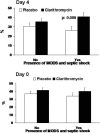Effect of clarithromycin in inflammatory markers of patients with ventilator-associated pneumonia and sepsis caused by Gram-negative bacteria: results from a randomized clinical study
- PMID: 22564837
- PMCID: PMC3393410
- DOI: 10.1128/AAC.05798-11
Effect of clarithromycin in inflammatory markers of patients with ventilator-associated pneumonia and sepsis caused by Gram-negative bacteria: results from a randomized clinical study
Abstract
One recent, double-blind, randomized clinical trial with 200 patients showed that clarithromycin administered intravenously for 3 days in patients with ventilator-associated pneumonia (VAP) accelerated the resolution of pneumonia and decreased the risk of death from septic shock and multiple organ dysfunctions (MODS). The present study focused on the effect of clarithromycin on markers of inflammation in these patients. Blood was drawn immediately before the administration of the allocated treatment and on six consecutive days after the start of treatment. The concentrations of circulating markers were measured. Monocytes and neutrophils were isolated for immunophenotyping analysis and for cytokine stimulation. The ratio of serum interleukin-10 (IL-10) to serum tumor necrosis factor alpha (TNF-α) was decreased in the clarithromycin group compared with the results in the placebo group. Apoptosis of monocytes was significantly increased on day 4 in the clarithromycin group compared with the rate of apoptosis in the placebo group. On the same day, the expression of CD86 was increased and the ratio of soluble CD40 ligand (sCD40L) to CD86 in serum was unchanged. The release of TNF-α, IL-6, and soluble triggering receptor expressed on myeloid cells-1 (sTREM-1) by circulating monocytes after stimulation was greater in the clarithromycin group than in the placebo group. The expression of TREM-1 on monocytes was also increased in the former group. These effects were pronounced in patients with septic shock and MODS. These results suggest that the administration of clarithromycin restored the balance between proinflammatory versus anti-inflammatory mediators in patients with sepsis; this was accompanied by more efficient antigen presentation and increased apoptosis. These effects render new perspectives for the immunotherapy of sepsis.
Figures







References
-
- Giamarellos-Bourboulis EJ. 2010. What is the pathophysiology of the septic host upon admission? Int. J. Antimicrob. Agents 36(Suppl 2):S2–S5 doi:10.1016/j.ijantimicag.2010.11.003 - DOI - PubMed
-
- Giamarellos-Bourboulis EJ, et al. 2006. Early apoptosis of blood monocytes in the septic host: is it a mechanism of protection in the event of septic shock? Crit. Care 10:R76 doi:10.1186/cc4921 - DOI - PMC - PubMed
-
- Giamarellos-Bourboulis EJ, et al. 2008. Effect of clarithromycin in patients with sepsis and ventilator-associated pneumonia. Clin. Infect. Dis. 46:1157–1164 - PubMed
-
- Giamarellos-Bourboulis EJ, et al. 2011. Inhibition of caspase-1 activation in Gram-negative sepsis and experimental endotoxemia. Crit. Care 15:R27 doi:10.1186/cc9974 - DOI - PMC - PubMed
Publication types
MeSH terms
Substances
LinkOut - more resources
Full Text Sources
Medical
Research Materials

